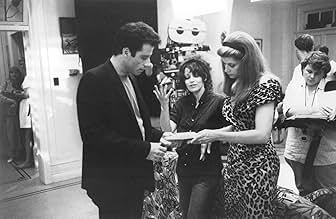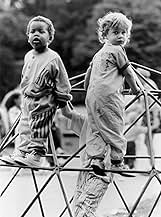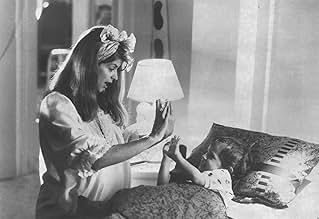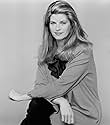AVALIAÇÃO DA IMDb
4,7/10
50 mil
SUA AVALIAÇÃO
Desta vez, um novo bebê está chegando, e é uma menina. Preso no conflito normal entre mãe e pai, Mikey se envolve em uma leve rivalidade entre irmãos com sua irmã mais nova.Desta vez, um novo bebê está chegando, e é uma menina. Preso no conflito normal entre mãe e pai, Mikey se envolve em uma leve rivalidade entre irmãos com sua irmã mais nova.Desta vez, um novo bebê está chegando, e é uma menina. Preso no conflito normal entre mãe e pai, Mikey se envolve em uma leve rivalidade entre irmãos com sua irmã mais nova.
- Direção
- Roteiristas
- Artistas
- Prêmios
- 3 indicações no total
Bruce Willis
- Mikey
- (narração)
Roseanne Barr
- Julie
- (narração)
Damon Wayans
- Eddie
- (narração)
Mel Brooks
- Mr. Toilet Man
- (narração)
Avaliações em destaque
The sequal to Look who's talking never has and never will be better than the first. But the only thing that makes the movie stand out, is the comedy and wit of Roseanne. She has all the funny jokes, she's cuter than what is now the baby Mikey, and she also tells what a baby might REALLY think. This movie should only be for Roseanne fans.
My review was written in December 1990 after a screening on Manhattan's UES.
This vulgar sequel to 1989's longest-running sleeper hit is assured of big openings due to its predecessor's familiarity but bad word of mouth should guarantee weak legs.
Few predicted the success of the same team's "Look Who's Talking", launched after delays in October 1989 to enjoy an unusually long 30-week U. S. run en route to ranking among the '89-'90 international box office leaders.
Credit TriStar with getting a followup into theaters in timely fashion to maximize its box office potential, but the resulting mishmash looks like a rush job.
Joined by her husband Neal Israel (who also appears as star Kirstie Alley's mean boss) in the scripting, filmmaker Amy Heckerling overemphasizes toilet humor and expletive - none deleted - to make the film appealing mainly to adolescents rather than an across-the-board family audience.
Unwed mom Alley and cabbie John Travolta are married for the sequel, with her cute son metamorphosed into Lorne Sussman, still voice-overed as precocious by Bruce Willis. First mutual arrival is conceived during a clever title sequence in which some sperm (also getting comical voice-overs) manage to find a way around Alley's diaphragm and fertilize an egg.
What hatches is undeniably cute Megan Miller (at 1 year old, after infants Nikki Graham and Georgia Keithley voiced over baby Julie), unforunately voiced over by Roseanne Barr. The comedienne gets a couple of laughs but is generally dull, leaving Willis to again carry the load in the gag department with well-read quips.
Lack of an interesting plot line is evident throughout the sequel's abbreviated 81-minute running time. Ostensibly it revolves around the bickering of Alley and Travolta whose jobs (accountant and would-be airplane pilot) and personalities clash, as well as the rites of passage of the two kids. New characters, notably Alley's obnoxious brother Elias Koteas, are added to ill effect.
An unconscionable amount of footage is devoted to the issue of potty training. Mel Brooks is enlisted to voice-over Mr. Toilet Man, a fantasy bathroom bowl come to life, spitting blue water and anxious to bite off Mikey's privates. Family's ecstatic reactions to Mikey finally learning toiletiquette is pure corn.
Alley and Travolta are a likable team that play off each other well. Too bad Hollywood doesn't take a leaf from the Golden Age and find new material for such romantic combos (a la '30 Fred MacMurray/Carole Lombard or '40s Tracy/Hepburn teamings) rather than merely recycle them in the sequel craze.. Both youngsters are cute enough to please an undemanding audience, and with an eye towards the cash register a third infant lovable black tot Danny Pringle, is added in a few scenes as a precociously streetwise playmate for Mikey.
Richard Pryor originally was signed to voice-over Pringle's wisecracks but was inexplicably replaced by Damon Wayans who does a good job in delivering knowing but young-sounding jive. All three kids articulate while the voicing occurs in a non-match that resembles the visual effect of a dubbed-in-English Japanese horror movie.
One cute gag involves the playing of the TriStar logo musical theme (by Dave Grusin) to climax a scene where Richard Strauss' "Thus Sprach Zarathustra" form "2001: A Space Odyssey" is traditionally employed. Elsewhere there's plenty of paid-for plugola.
With Koteas a gun-toting babysitter who abandons the kis to an accidental fire in their apartment, film strays far from good taste and good sense in a desperate search for gags. Various creature effects, notably Julie growing in mom's womb, are well executed by Chris Walas' organization and New York locale for this Vancouver-lensed effort is adequately fake by some second unit shots.
Conspicuous sequel "beefing up" is most evident in pointless inclusion of many golden oldies on the soundtrack, ranging from expensive Elvis Presley tracks (allowing Travolta to throw in one of his trademark dance numbers) to John Lennon and George Harrison.
This vulgar sequel to 1989's longest-running sleeper hit is assured of big openings due to its predecessor's familiarity but bad word of mouth should guarantee weak legs.
Few predicted the success of the same team's "Look Who's Talking", launched after delays in October 1989 to enjoy an unusually long 30-week U. S. run en route to ranking among the '89-'90 international box office leaders.
Credit TriStar with getting a followup into theaters in timely fashion to maximize its box office potential, but the resulting mishmash looks like a rush job.
Joined by her husband Neal Israel (who also appears as star Kirstie Alley's mean boss) in the scripting, filmmaker Amy Heckerling overemphasizes toilet humor and expletive - none deleted - to make the film appealing mainly to adolescents rather than an across-the-board family audience.
Unwed mom Alley and cabbie John Travolta are married for the sequel, with her cute son metamorphosed into Lorne Sussman, still voice-overed as precocious by Bruce Willis. First mutual arrival is conceived during a clever title sequence in which some sperm (also getting comical voice-overs) manage to find a way around Alley's diaphragm and fertilize an egg.
What hatches is undeniably cute Megan Miller (at 1 year old, after infants Nikki Graham and Georgia Keithley voiced over baby Julie), unforunately voiced over by Roseanne Barr. The comedienne gets a couple of laughs but is generally dull, leaving Willis to again carry the load in the gag department with well-read quips.
Lack of an interesting plot line is evident throughout the sequel's abbreviated 81-minute running time. Ostensibly it revolves around the bickering of Alley and Travolta whose jobs (accountant and would-be airplane pilot) and personalities clash, as well as the rites of passage of the two kids. New characters, notably Alley's obnoxious brother Elias Koteas, are added to ill effect.
An unconscionable amount of footage is devoted to the issue of potty training. Mel Brooks is enlisted to voice-over Mr. Toilet Man, a fantasy bathroom bowl come to life, spitting blue water and anxious to bite off Mikey's privates. Family's ecstatic reactions to Mikey finally learning toiletiquette is pure corn.
Alley and Travolta are a likable team that play off each other well. Too bad Hollywood doesn't take a leaf from the Golden Age and find new material for such romantic combos (a la '30 Fred MacMurray/Carole Lombard or '40s Tracy/Hepburn teamings) rather than merely recycle them in the sequel craze.. Both youngsters are cute enough to please an undemanding audience, and with an eye towards the cash register a third infant lovable black tot Danny Pringle, is added in a few scenes as a precociously streetwise playmate for Mikey.
Richard Pryor originally was signed to voice-over Pringle's wisecracks but was inexplicably replaced by Damon Wayans who does a good job in delivering knowing but young-sounding jive. All three kids articulate while the voicing occurs in a non-match that resembles the visual effect of a dubbed-in-English Japanese horror movie.
One cute gag involves the playing of the TriStar logo musical theme (by Dave Grusin) to climax a scene where Richard Strauss' "Thus Sprach Zarathustra" form "2001: A Space Odyssey" is traditionally employed. Elsewhere there's plenty of paid-for plugola.
With Koteas a gun-toting babysitter who abandons the kis to an accidental fire in their apartment, film strays far from good taste and good sense in a desperate search for gags. Various creature effects, notably Julie growing in mom's womb, are well executed by Chris Walas' organization and New York locale for this Vancouver-lensed effort is adequately fake by some second unit shots.
Conspicuous sequel "beefing up" is most evident in pointless inclusion of many golden oldies on the soundtrack, ranging from expensive Elvis Presley tracks (allowing Travolta to throw in one of his trademark dance numbers) to John Lennon and George Harrison.
This was an inevitable sequel, that was really not all that of a movie. It was charming at most, but too many poopoo jokes, and other ridiculous stuff. I give it sequel: 4.5 out of 10. Rated PG-13 for crude humor, thematic elements, and language.
In general, sequels aren't as good as their predecessors, and Look Who's Talking Too is no exception. The first one was adorable, with Kirstie Alley's baby, voiced by the hilariously perfect Bruce Willis, giving an inner monologue about his first impressions on the world. The cast is all back, and the romance with Kirstie and John Travolta continues, but there's a new addition: a new baby. Roseanne Barr provides the voice for Bruce's baby sister, and his entire world changes for the worse.
The problem with this movie is it's too painful and realistic. First borns will delight in Bruce stealing Roseanne's toys and playing pranks as older brothers are known to do, but they'll also remember that when their younger siblings were born, they, too, suffered a loss. The older child immediately gets put on the back burner and the new baby takes the spotlight. Many children never grow out of their resentment throughout their lives, so watching little babies fight and squabble isn't very fun. Plus, the first movie only had Bruce Willis's inner thoughts, and he was a very cute baby. What's better: a cute baby or a gruff baby? Cute babies win every time, and every time Rosanne talks, she's not very endearing.
DLM Warning: If you suffer from vertigo or dizzy spells, like my mom does, this movie might not be your friend. There are a couple of shots filmed from the baby's perspective, and it might make you sick. In other words, "Don't Look, Mom!"
The problem with this movie is it's too painful and realistic. First borns will delight in Bruce stealing Roseanne's toys and playing pranks as older brothers are known to do, but they'll also remember that when their younger siblings were born, they, too, suffered a loss. The older child immediately gets put on the back burner and the new baby takes the spotlight. Many children never grow out of their resentment throughout their lives, so watching little babies fight and squabble isn't very fun. Plus, the first movie only had Bruce Willis's inner thoughts, and he was a very cute baby. What's better: a cute baby or a gruff baby? Cute babies win every time, and every time Rosanne talks, she's not very endearing.
DLM Warning: If you suffer from vertigo or dizzy spells, like my mom does, this movie might not be your friend. There are a couple of shots filmed from the baby's perspective, and it might make you sick. In other words, "Don't Look, Mom!"
Look Who's Talking Too (1990)
* 1/2 (out of 4)
John Travolta and Kirstie Alley return in this "the first one made money so let's rush a sequel" film, which also has Bruce Willis returning as the voice of Mikey. This time out a new baby sister (voiced by Roseanne Barr) causes the parents to stress out and break up, which isn't easy on either kid. That's pretty much the only thing, story wise, that this sequel offers and it's clear that very little effort went into the production. It's really pathetic whenever so much energy goes into making a good film and then the producers just turn their back on that energy that made the first film so good and they just rush out whatever they can no matter how bad it is. LOOK WHO'S TALKING TOO really doesn't do anything right as we're just given situations that were covered in the first film but here they're not cute and they're especially not funny. This is a pretty poor film that only mildly works because it's constantly begging you to overlook all the flaws because the first film was so cute. In fact, the highlight of this sequel is a quick sequence when we get some flashback scenes from the first movie. The entire "joke" here deals with the parents trying to potty train Mikey and this leads to some really embarrassing moments including a singing session between the adults, a really bad "best friend" (voiced by Damon Wayans) who is always talking about the poo-poo monster and then there's the monster toilet (voiced by Mel Brooks), which is just downright embarrassing. In between all the unfunny jokes we're given some pretty bad dramatic moments including some stuff with the parents fighting in front of the kids and the finale with the fire really just seems out of place. The performances are all pretty boring as well as the two leads just sleepwalk through their roles and Barr is just horrid given some pretty bad dialogue to say. Willis is energetic at least but the dialogue does him no favors. Somehow, the producers managed to squeeze one more film out of the series and things were only going to get worse.
* 1/2 (out of 4)
John Travolta and Kirstie Alley return in this "the first one made money so let's rush a sequel" film, which also has Bruce Willis returning as the voice of Mikey. This time out a new baby sister (voiced by Roseanne Barr) causes the parents to stress out and break up, which isn't easy on either kid. That's pretty much the only thing, story wise, that this sequel offers and it's clear that very little effort went into the production. It's really pathetic whenever so much energy goes into making a good film and then the producers just turn their back on that energy that made the first film so good and they just rush out whatever they can no matter how bad it is. LOOK WHO'S TALKING TOO really doesn't do anything right as we're just given situations that were covered in the first film but here they're not cute and they're especially not funny. This is a pretty poor film that only mildly works because it's constantly begging you to overlook all the flaws because the first film was so cute. In fact, the highlight of this sequel is a quick sequence when we get some flashback scenes from the first movie. The entire "joke" here deals with the parents trying to potty train Mikey and this leads to some really embarrassing moments including a singing session between the adults, a really bad "best friend" (voiced by Damon Wayans) who is always talking about the poo-poo monster and then there's the monster toilet (voiced by Mel Brooks), which is just downright embarrassing. In between all the unfunny jokes we're given some pretty bad dramatic moments including some stuff with the parents fighting in front of the kids and the finale with the fire really just seems out of place. The performances are all pretty boring as well as the two leads just sleepwalk through their roles and Barr is just horrid given some pretty bad dialogue to say. Willis is energetic at least but the dialogue does him no favors. Somehow, the producers managed to squeeze one more film out of the series and things were only going to get worse.
Você sabia?
- CuriosidadesThe Learjet featured in the movie was owned by John Travolta at the time the movie was made. Tail number N254JT. JT = John Travolta.
- Erros de gravaçãoWhen Mollie and James are having an argument in the hallway in front of their apartment, the door to their apartment is sometimes ajar, sometimes wide open.
- Citações
Mollie Ubriacco: Mommy is a girl, so I don't have a penis.
James Ubriacco: But she's got some set of balls.
Mollie Ubriacco: But Daddy is a big...
Mikey: Penis!
- Cenas durante ou pós-créditosAt the beginning, the Tri-Star Pictures horse is talking about running and when he starts to fly he says "I have wings! Tri-Star Pictures - Anything can happen!". Later in the film the same Tri-Star Pictures theme is used.
- Versões alternativasThe UK cinema version was cut by the BBFC to remove the line "Why don't you put me in a fucking dress?". The cut was restored to all later releases.
- ConexõesFeatured in Troldspejlet: Episode #4.5 (1991)
- Trilhas sonorasAll Shook Up
Written by Otis Blackwell & Elvis Presley
Performed by Elvis Presley
Courtesy of RCA Records
Principais escolhas
Faça login para avaliar e ver a lista de recomendações personalizadas
Detalhes
- Data de lançamento
- País de origem
- Idioma
- Também conhecido como
- Mira quién habla también
- Locações de filme
- Empresas de produção
- Consulte mais créditos da empresa na IMDbPro
Bilheteria
- Faturamento bruto nos EUA e Canadá
- US$ 47.789.074
- Fim de semana de estreia nos EUA e Canadá
- US$ 8.100.640
- 16 de dez. de 1990
- Faturamento bruto mundial
- US$ 47.789.074
- Tempo de duração1 hora 21 minutos
- Cor
- Proporção
- 1.85 : 1
Contribua para esta página
Sugerir uma alteração ou adicionar conteúdo ausente

Principal brecha
By what name was Olha Quem Está Falando Também (1990) officially released in India in English?
Responda

































